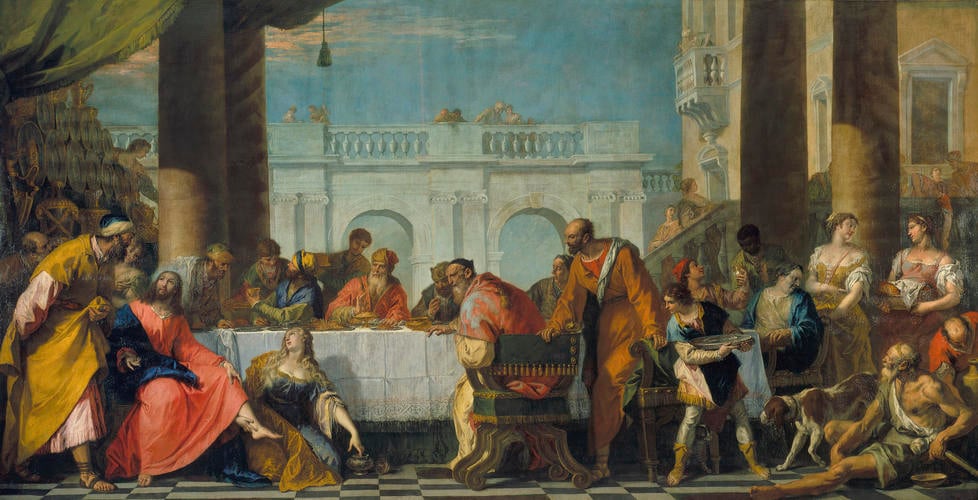The Magdalen Anointing Christ's Feet c.1720-30
Oil on canvas | 322.6 x 632.5 cm (support, canvas/panel/stretcher external) | RCIN 405742
-
The subject of the anointing of Christ's feet is from Luke 7.37-40. The setting is a pillared courtyard or terrace, indicating the feast in the house of Simon the Pharisee. A penitent sinner, traditionally identified as Mary Magdalen, brought a box of ointment to the feast, washed Christ's feet with her tears, wiped them with her hair, and then anointed them. Here Christ sits on the left, with the Magdalen kneeling at his feet anointing them with oil from a silver bowl. Christ looks up to a standing figure on the left, who is probably Simon. The bald-headed figure standing slightly to the right of the centre, who has risen from the table to witness the Magdalen's action, must be meant for Judas. Although his presence is not mentioned by Luke, he is recorded in John 12.3-6 when he protests at the waste of money involved in the anointing of Christ's feet by Mary, sister of Martha, at the supper in Bethany. Another parable appears to be conflated in the inclusion of the figure of a beggar with a dog at the far right of the composition. the parable of Dives and Lazarus derives from Luke 16.19-22, and tells of the poor man who lay at the rich man's gate, desiring to be fed and 'the dogs came and licked his sores'.
The composition is overwhelmingly indebted to Veronese, who also placed Christ and the Magdalen in the extreme right of his composition of the same subject in the Brera, Milan. The poses of the figures of the Magdalen, Judas, and the beggar are taken from other works by Veronese. There exist a number of preparatory studies for the composition; their likely evolution begins with a small oil sketch also in the royal collection (RCIN 404769).
The Venetian artist Sebastiano Ricci travelled extensively in Europe, working all over Italy and in Vienna and London. His style developed from the late baroque of Luca Giordano to the delicacy and elegance of the rococo. On his return to Venice from England in 1716 Sebastiano, with his nephew Marco, produced the series of seven large paintings of New Testament subjects to which this picture belongs. Marco contributed the architectural backgrounds. In 1742 Joseph Smith had the paintings engraved by J.M. Liotard as in his collection and they were described in 1749 in a volume published by Smith's protegé Giambattista Pasquali; the volume was issued anonymously but the author was Abate Pietr'Ercole Gherardi of Modena.
Six of the series are still in the Royal Collection; two are now on loan to the National Trust at Osterley Park, and one is lost. The large scale and subject-matter of the paintings have prompted the suggestion that the series was commissioned by a member of the royal house of Savoy in Turin, for whom Sebastiano and Marco Ricci undertook many commissions in the 1720s; it is further suggested that the paintings were only acquired by Smith when the commission fell through. It is more likely, however, that Smith commissioned the series himself. The 1742 and 1749 publications indicate his pride of ownership, as part of his large collection of Ricci paintings and drawings. His ownership of sixteen preparatory drawings for the Adoration of the Magi may indicate that he was involved with the project from the outset. George Knox has outlined the way in which the series might have been hung in a single room in Smith's house in Venice, before the house was altered in the 1740s, when the series could have been displayed in two rooms.
The painting was cleaned in 1979.Provenance
Acquired in 1762 by George III from Joseph Smith, British Consul in Venice (Italian List no 28); recorded in the Public Dining Room at Hampton Court in Pyne's Royal Residences of 1819
-
Medium and techniques
Oil on canvas
Measurements
322.6 x 632.5 cm (support, canvas/panel/stretcher external)
342 x 637 x 0 cm (frame, external)
Category
Object type(s)








